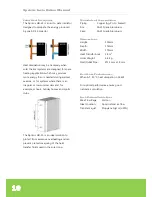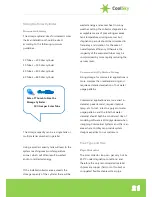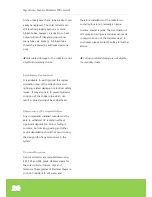
Apricus Installation Manual
26
Wind & Structural Loading
Components must be able to withstand
environmental forces such as wind loading,
snow loading, rain and hail. They must also
be securely and positively fastened to the
structure.
Collector wind loading must be considered
and the resulting stress on attachment
points thoroughly examined.
The standard Apricus Frame and Frame Kits
are all designed to withstand wind speeds of
up to 130 mph (208 km/h) without damage,
which corresponds to the mid-range of
Category 2 cyclones (US Saffir-Simpson
scale).
Table A provides peak vertical pull forces and
horizontal (pushing) forces for an AP-30
collector. These values represent both rear
and frontal winds. The highest force of 180
kg on the middle, front foot at a 60
°
collector angle is actually from a frontal, and
not rear, wind as it is trying to tip the
collector backward.
Based on the figures provided in Table A, the
weight of individual concrete blocks or the
strength of fixation points requirements can
be determined.
NOTE :
A safety factor of at least 1.2 should be
used, or as specified by local building
regulations, whichever is higher.
30
o
Angle
45
o
Angle
60
o
Angle
30
o
Angle
45
o
Angle
60
o
Angle
Front Middle
22
8
40
59
100
180
Front Left/Right
15
13
43
32
74
100
Rear Middle
38
85
122
18
31
66
Rear Left/Right
32
78
114
17
24
58
Combined Load
156
275
488
127
327
808
Round Foot
Peak Vertical Pull Load [kg]
Peak Forward-Backward Load [kg]
Table A
–
Showing the Peak Loads on the Collector Feet when subjected to wind
speeds of 130 mph (208 km/h)
















































